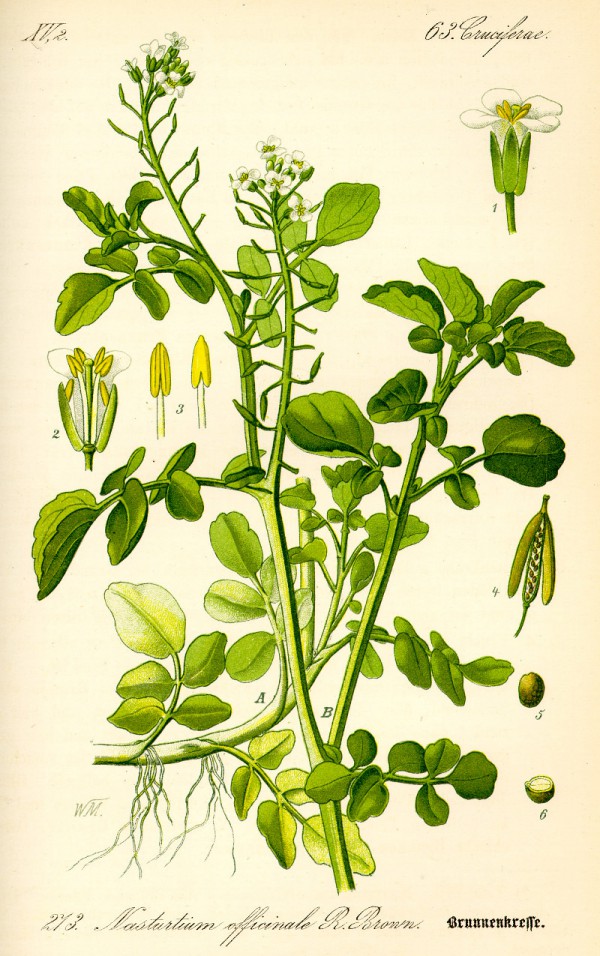Nasturtium officinale W. T. Aiton - syn. Nasturtium officinale R.Br.; Rorippa nasturtium-aquaticum (L.) Hayek - Brassicaceae
water cress, Gemeine Brunnenkresse, Brunnenkresse, Wasserkresse
Native to central and western Europe; perennial aquatic plant with floating, freely rooting hollow stems, 10-80cm long; leaves odd pinnate, with characteristic shape and pungent taste, staying green in autumn; tiny white flowers with yellow anthers; fruit a pod, 10-18mm long and 2-2.5mm broad.
„The water should always flow so that it is sufficiently cleaned. The harvest period extends from September to the beginning of flowering in May. In extensively driven culture, the plants remain up to ten years in culture. In intensive cultivation, the culture of each year or created after two years…
This ancient medicinal plant is considered an aphrodisiac and appetizer, as metabolically promoting, and diuretic. It is recommended for the „purification“ of the liver, lung and stomach.“
http://de.wikipedia.org/wiki/Echte_Brunnenkresse
The plant is commercially cultivated in England (Alresford eg.) and US. (Alabama, Florida). Watercress contains significant amounts of iron, calcium, iodine, and folic acid, in addition to vitamins A, C and K.http://en.wikipedia.org/wiki/Watercress
„Volatile constituents of the dried leaves and stems of Nasturtium officinale R. Br. collected after hydrolysis were analyzed by GC and GC/MS. The major volatile constituents of the leaves were 2-phenylethyl isothiocyanate (72.9%), pulegone (8.0%), heptyl isothiocyanate (4.9%) and 4-phenylbutyl isothiocyanate (3.2%), while the main volatile constituents of the stems were 2-phenylethyl isothiocyanate (83.5%), 4-phenylbutyl isothiocyanate (6.9%), pulegone (2.2%) and sec-butyl isothiocyanate (1.9%).“
[Volatile Constituents of Leaves and Stems of Nasturtium officinale R. Br., Suleiman Afsharypuor, Ma'soumeh Salehi, Journal of Essential Oil Research, Vol.20 (6), 2008, 517-518]
„Phenethyl isothiocyanate (PEITC), a natural dietary isothiocyanate, has anti-cancer activity in various in vitro and in vivo models… We have now demonstrated that PEITC is an effective inhibitor of hypoxia inducible factor (HIF), a transcription factor that plays an important role in expression of pro-angiogenic factors… Our data demonstrate that PEITC is an effective inhibitor of HIF activity. This may contribute to the anti-angiogenic and anti-cancer effects of PEITC.“
[Inhibition of hypoxia inducible factor by phenethyl isothiocyanate, Xiu-Hong Wang, Breeze E. Cavell, Sharifah S. Syed Alwi, Graham Packham, Biochemical Pharmacology, Vol.78 (3), 2009, 261–272]

Thomé, O.W., Flora von Deutschland Österreich und der Schweiz, Tafeln, vol.2, t.273 (1885)
http://plantgenera.org/species.php?id_species=692571
Nasturtium officinale © Rolf Marschner (2018)
www.botanische-spaziergaenge.at
